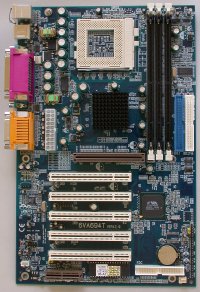 |
If you have seen this page before, you will want to read the update (Feb. 2008) at the bottom of this page, about the installation of the Asus M3A and the AMD Phenom 9600 Quad-Core processor, followed by my initial review of Windows 7.
This page offers a basic introduction to building your own computer. Even though the motherboards I show on this page are now considered "old," the method for assembly remains basically the same. There are photos of a newer motherboard (Asus M3A and AMD Phenom 9600) at the bottom of this page for comparison. There are minor differences between the methods depending on the motherboard you choose. The first thing to know is NOT to buy a motherboard that does not come with an instruction manual and the CD with driver software. If the manual and the CD are not included, look elsewhere! Choose a work area that does not have carpeting, and avoid clothing that tends to build up static electricity. If you do not have a ground strap, touch the work bench or the computer case every five seconds or so to prevent static buildup in your hands. Static electricity could easily ruin your computer components, so be very careful. I chose the Altos AL-694T motherboard with a Pentium 733 processor for this demonstration. Click on the photos to view enlargements.
 |
Lift the lever on the base before placing the processor in position. There are two notches that need to be aligned (photo enlargement: see arrows). Do not touch the pins on the processor: touch the processor only around the edges, as if it were a collectible coin. The processor should fit in place effortlessly before pushing the lever down into place.
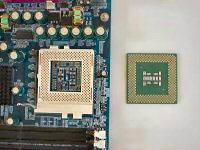 |
Apply a very small amount of cpu thermal paste (not shown in this photo) onto the central area of the processor, where it makes contact with the heatsink, spreading the paste evenly (I used a wooden toothpick for this).
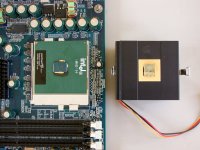 |
Position the heatsink and fan assembly so that the heatsink lies parallel to the base, and place one end of the spring bar into the base, as shown.
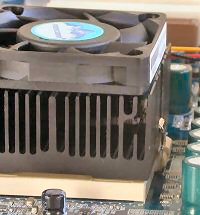 |
Push the other end down into the notch on the base. I used a pair of needlenose pliers to push down and a small screwdriver to guide the part into place.
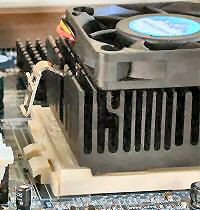 |
Plug the processor fan into the motherboard. It usually says something like "CPU_FAN" on the board where you plug in the wire.
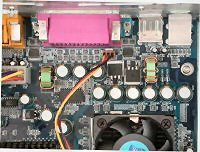 |
The memory stick has a notch in the middle to prevent you from putting it in incorrectly. Do not touch the contacts with your fingers.
 |
Push the memory stick vertically into the first memory slot, as marked on the motherboard (usually nearest the processor), until the white tabs at the ends are pushed in.
 |
Computer cases are designed to be suitable for many different motherboards. Insert the brass mounts into the case, as shown in the enlargement, to match the holes in the motherboard. Before you begin any work in the computer case, turn off the power supply on the back of the case and unplug the external wire from the wall, if this has not already been done!
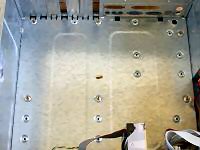 |
Make sure all the wires are out of the way before installing the motherboard. The enlargement shows what the wires from the power supply in the case are for.
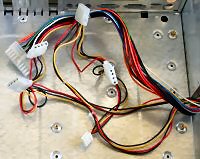 |
Carefully position the motherboard in the case.
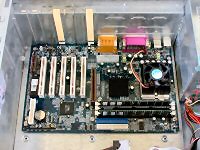 |
Make sure the ports are correctly positioned in the back of the case before you insert all the screws needed to secure the motherboard in the case.
 |
My next step was to insert the AGP video card (left) and the PCI modem (right).
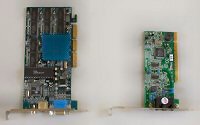 |
Place the notch at the base of the video card into position, and then the metal tab into the case, before pushing the video card vertically down into place. Insert a case screw to hold the video card in place, as shown. For the modem (and any other PCI component), simply place the metal tab into the case and push the card vertically down into position. Do not touch the contacts: hold all computer components as you would hold a collectible coin.
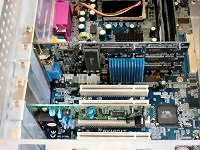 |
Plug the case wires into the motherboard in the bottom right hand corner. This motherboard was easy and self-explanatory. Other motherboards often require that you check the instruction manual before plugging in the wires. The most important wires are the power switch (on/off) and the reset switch.
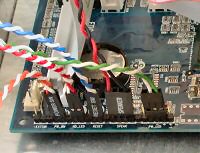 |
The hard drive goes in from inside the case. However, the floppy drive, the zip drive, and the CD-ROM all go in through the front of the case. (Most computers do not have zip drives, so you can ignore it.) Two screws hold each hardware component in place, as shown. If you wanted to, you could install two more screws on the other side, but this is usually not needed.
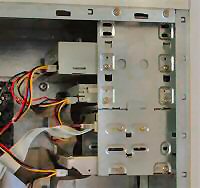 |
The motherboard should come with three IDE cables. I used one of the larger ones to connect the CD-ROM and the zip drive to the motherboard. One side of the IDE cable is painted red, as shown. Notice its position (towards you).
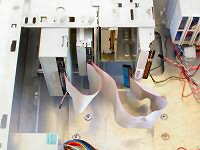 |
Insert the power cables into the components. The shape of each plug determines how you insert it. There is a small cable connected to the CD-ROM (red wire to the left) that is connected in a different place on the motherboard ("CD_IN").
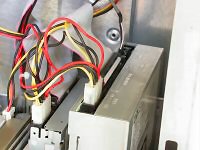 |
On this motherboard, the CD_IN plug is next to the PCI slots. Plug it in (red to the left).
 |
The smaller IDE cable is connected to the floppy drive. Notice that the red edge of the cable faces the other side, when compared to the IDE cable connected to the CD-ROM. The small power supply cable is connected to the floppy drive (with its red wire facing the other side, when compared to the power supply cable connected to the CD-ROM, as shown). The other large IDE cable is connected to the hard drive in the same manner as the CD-ROM. The IDE cable allows you to connect two hard drives, if you wanted to. Do not change the position of the jumper on the hard drive unless you install more than one hard drive and you have the instructions that come with the hard drive. The power supply cable is also connected to the hard drive in the same manner as to the CD-ROM.
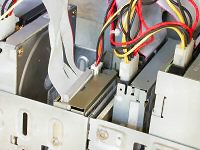 |
The other end of the IDE cable connected to the hard drive is plugged into the IDE1 slot on the motherboard. The other end of the IDE cable connected to the CD-ROM is plugged into the IDE2 slot on the motherboard. The smaller IDE cable connected to the floppy drive is plugged into the IDE3 slot (which says "floppy" or "FDC"). The three IDE slots are normally together, but this motherboard has the IDE3 slot next to the case wires on the bottom right hand corner. The shape of the plug makes it possible to connect the cable in one way only.
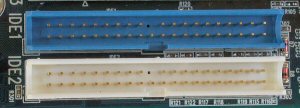 |
Last (but not least), plug the power supply cable into the motherboard. Plug in the keyboard, mouse, and monitor into the back of the case. Plug the external power supply cables for the computer and the monitor into a surge protector (very important) and turn on your system.
 |
The WCPUID software provides a neat summary of the information about the processor and memory.
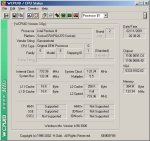 |
The last photo shows another motherboard, an Asus P5S-VM from an HP computer. The arrangement is slightly different, but the procedure for assembly is basically the same. The biggest difference here is that this motherboard does not have an AGP slot for a video card. The video card is built into the motherboard. I prefer a motherboard with an AGP slot.
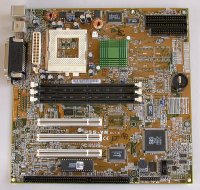 |
If you have read this far, I wish you luck in building your next computer. Now a few words of caution: the fact that you have built it correctly does not mean it will work correctly. This may sound somewhat sarcastic, but I have had problems with several different motherboards that would not allow me to run some of my older software (which I did not want to lose). In addition to software compatibility issues, you may also experience hardware compatibility issues. The 64 MB video card in this computer did not work in my new AZZA motherboard, so I had to buy another 64MB video card that did work. When I tried to buy more memory for my Altos motherboard, none of the memory sticks I tried worked smoothly on my motherboard, so I had to be satisfied with what I already had. The fact that it fits does not mean it will work. This means you must experiment with different components until you get a smooth-running system.
The contents of this page, therefore, merely provide the most basic introduction to building your own computer. Proceed at your own risk. To succeed, you will need a good friend to help you get started and a good computer store to sell you the components you need and to work with you until you solve all your computer problems. Learning to build my own computer was a major challenge for me. Installing the software and getting it to work took much longer than building the computer, and caused much anxiety. Once all the problems were solved, however, the rewards were immeasurable ![]() .
.
Install the modem and other PCI cards after you install Windows. Shut down and unplug the computer. Install the modem. Start the computer and install the modem software. Repeat for each additional PCI card, one at a time.
FEBRUARY 2008: After getting my hands on one of the newest processors, it was time to build a new computer! Below are a few photos of the Asus M3A motherboard with the AMD Phenom 9600 Quad-Core Processor, which were released in November, 2007. The procedure for installation is almost the same as I outlined above years ago, so I am leaving that part of the webpage unchanged and adding to it. These photos show how the appearance of the components have changed, yet the method for installation remains essentially the same.
 |
The socket for the new AM2+ processor has a black plastic ring around it for the fan. The memory has changed to DDR2. The video card has changed to PCIe. The hard drive and the DVD burner are now SATA. All computers now have USB 2.0 for external hard drives, wireless internet connections, and other accessories. The procedure for installation has changed very little. Match the pattern of the processor to its stocket for an effortless installation.
 |
The fan clamps over the processor as before.
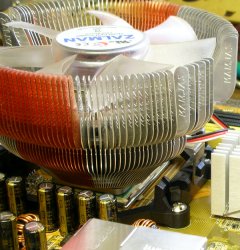 |
Install the DDR2 memory and then install the motherboard into the case. If you plan to install Windows Vista, you want to install as much memory as your motherboard will accept. Vista is greedy! I installed 8 Gigs of DDR2 on this M3A motherboard, even though 32 bit XP and Vista will only use up to 3.3 Gigs. After some experiments, I found that the computer does run better with 8 Gigs than with 4 Gigs. To take better advantage of the memory, you could install the 64 bit version of Windows, but this has all kinds of compatibility problems with hardware and drivers.
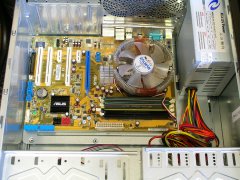 |
Plug the SATA cables into the DVD burner and the hard drive.
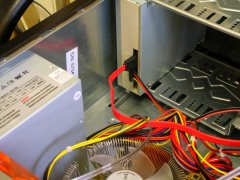 |
The video card I installed is a XFS GeForce 7300 GT, a modest PCIe card. If you want to play games, I recommend something more powerful. However, this card is probably a hundred times more powerful than anything I need it for. I like it because it has a large and heavy heatsink without one of those fragile little cooling fans. I suspended a larger fan under it to keep it cool. If you want to carry your computer around frequently, I recommend a more rigid method of mounting this fan into place. There are three other case fans installed in this computer, which adds a lot to the wiring and makes the setup look messy, but they are needed because of the amount of heat the Phenom 9600 processor generates. A case fan is mounted in front of the case, bringing air in from the front and keeping the hard drive cool. Two more case fans are mounted to the back of the case, expelling hot air from the processor through the back of the case.
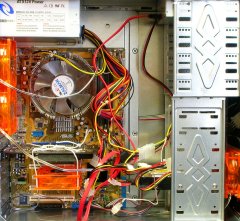 |
There were no problems turning this computer on, and installing Windows Vista was a breeze. Having experimented with three versions of Vista, I can make some comments here. First of all, Vista is not compatible with many hardware devices, such as older printers, scanners, wireless internet connectors, and modems, to name a few. Therefore, do not install Vista unless you have another computer that you will keep with Windows XP. Vista Home Basic gave me some problems with installation. Vista Ultimate made my computer run very slowly, even after I had turned off all the fancy features and eye-candy, such as the Aero display, and adjusted the settings for best performance. I got the best results with Vista Home Premium, after turning off as many fancy features as I could, and adjusting the settings for best performance, thereby nullifying all of the "Premium" characteristics in Vista. Just because you paid for it does not mean you should use it. I also changed the exceptionally confusing start menu to the classic start menu. Vista has numerous updates when compared to XP, most notably in wireless internet performance, which is better than I have ever seen before. However, Vista has many security features, such as Windows Defender, which are not user-friendly and, quite frankly, result in a big headache. If you do not plan to take the time to learn how these features work, you should stick to XP because Vista is not a "get up and go" software. Another issue is driver software for the hardware. If Vista does not have the driver for that hardware and that hardware does not say "compatible with Vista" on the package, I do not install the driver and do not use that hardware. You can use that hardware on your computer with XP. Installing drivers that Vista does not like could cause Vista to crash, as happened to me, requiring me to install Vista all over again. I therefore use my computer with Vista only for internet, and I use my computer with XP for everything else.
As for processor performance, the numbers speak for themselves, though the difference in performance is really obvious. It is probably not a coincidence that "Phenom" rhymes with "venom" and may also be short for "Phenomenal Performance." The Phenom is a Quad-Core, which means it has FOUR (4) processors built onto one base. The performance numbers assume no overclocking.
| PROCESSOR | PCPITSTOP SPEED RATING |
|---|---|
| Pentium II 400 | 1072 |
| AMD Duron 1200 | 3231 |
| AMD Athlon XP 2500+ | 5329 |
| AMD Sempron 3000+ | 5263 |
| AMD Athlon 64 X2 Dual Core 4600+ | 16155 |
| AMD Phenom Quad-Core 9600 | 42319 |
The new AMD processors have an extraoardinary feature called Cool-n-Quiet. Intel processors have a similar feature. It was designed to prolong the battery life in laptop computers by slowing down the processor during periods of less activity, thereby saving energy and generating less heat, enabling the cpu fan to run at a slower speed, more quietly. It is a terrific feature if you have a laptop and need to save battery power. In the Asus M3A motherboard, this feature is disabled in the bios. If you enable this feature, you will find out why. The processor will run at half the normal speed, until heavy computing needs to be done, when it automatically adjusts to full speed. In reality, this feels like driving an eight-cylinder car on four cylinders (remember the Cadillac Seville with 8-6-4 ?). The Pentium II also had Cool-n-Quiet. After you try it, you will probably turn the Cool-n-Quiet feature off again. If you test your phenom on the pcpitstop website and get a performance score of about 15000, you want to disable to Cool-n-Quiet feature in the bios.
 |
The Asus M3A motherboard is a basic motherboard, designed to keep the cost low. Since I do not play games on my computer, this motherboard works very well for me. If you play games and want to use two video cards, you want the fully-loaded Asus M3A32-MVP, which has two PCIe slots and extensive use of heatsinks and heatpipes, so as not to burn up your computer while you make it scream!
8 May 2008 Update. Do yourself a favor: just say "Hasta la Vista," and "Hello XP."
4 July 2009 Update. I downloaded the trial version of the new Windows 7 operating system and this is probably one of the first evaluations or reviews on the internet. My first impressions are that it is fast, impressive, smooth, stable, and really astonishing when compared to Vista. I had some problems with the audio, but it is now working well. No other problems yet.
The version of Windows 7 available to developers, called Windows 7 RC, is Windows 7 Ultimate. The trial version will work until March of 2010, so there is still plenty of time to experiment with it. It has the kitchen sink, as it were, all the features and options Microsoft could throw at your computer. The presentation is terrific. It is easy to use. I had no trouble installing my old software. The improved program compatibility attributes may not be available in lesser versions of W7, so I would have preferred to experiment with a Home Basic edition. My Logitech mouse software for XP caused Vista to crash hard, such that I had to start all over and reinstall Vista, (but I ended up installing XP again later). I had no problems with W7. I think W7 is light-years ahead of Vista. I do not play games on my computer, but I would expect games to perform at least as well on W7 as on XP.
I am using an older computer, an Asus a8n-sli with an AMD 3500+ processor and one Gig. of DDR400 memory. The way W7 handles memory usage is the best ever. I installed Flock, Mozilla Firefox, Seamonkey, as well as experimenting with Internet Explorer 8, already in W7. My wireless adaptor was recognized instantly, and I had no trouble connecting to the internet. When I tested my internet performance in PCPitstop.com, the performance numbers were the highest I have ever seen on any of my computers in the last five years. Browser performance was instantaneous, and most webpages loaded as quickly as I have ever seen. Microsoft obviously put a lot of work into this operating system. Despite opening numerous webpages, Flock would not crash, as it does in my other computer with XP, no matter how far I pushed the limits. The internet experience in W7 is the best ever, in my opinion. Despite hours of trying to get my browser and my computer to crash, it did not. Maybe somebody else will prove me wrong.
After some hours of surfing the net, I wanted to see what information W7 had gathered about my activities. I found a huge number of files in my Temporary Internet Files folder; I cannot even count that high. I found 26 (twenty-six) index.dat files with lists of websites visited and every other activity, files opened, programs used. The issue of personal privacy would be of concern to someone who did not want his wife to find out what websites he has visited or whom else he has sent private messages to. Anyone with kids, who might download music or other files that they were not supposed to download, would be concerned about the trail of backup files on his computer, even after all the downloaded files were deleted. I was unable to view files in hidden folders in W7 as I could with XP, so obviously W7 does not want you to know what hidden files it has and where it collects data that it does not want you to know about. George Orwell would be proud.
To summarize: Windows 7 Ultimate is undoubtedly the best operating system Microsoft has ever produced, in my opinion, with five stars out of five all the way, if you are a saint. Gloria in excelsis Deo. If you are a saint with a wife and kids, stay with XP. If you are a flawed saint or are human, XP is your best bet. Your priest may be able to absolve you of your sins, but your computer will keep detailed catalogs of every pure and impure thought, which is even more true with W7 than with XP. You could also consider the Linux Ubuntu operating system, which can be downloaded for free. There is another software called Wubi that makes it easy to install Ubuntu from within the Windows operating system.
24 August 2009 Update. As a computer enthusiast, I have purchased a copy of Windows 7 for one of my computers. It continues to work very well. I have turned off all the fancy eye-candy, adjusting the settings for best performance. It continues to be a vast improvement over Vista, but not quite as fast as XP SP1, which is what I will continue to use on my main computer. When I install Windows, the first thing I do, before connecting to the internet, is to turn off all automatic updates. While that may concern those who worry about viruses, I must say that I have had far fewer problems with viruses than I have had with Windows, particularly Windows Automatic Updates and System Restore. I do, however, protect my computer from viruses by using a firewall from Zonealarm, which you can download for free.
1 November 2009 Update. My new Windows 7 Home Premium Upgrade finally arrived from Amazon and I have installed it on my newest computer, the Phenom above. I discovered immediately that the upgrade only works from the much-maligned Vista, not from XP. This did not affect me because I always opt to perform a clean installation, having had so much trouble with Microsoft upgrades and updates in the past, but many XP customers will be extremely upset. If you have XP, you should therefore not change to Windows 7. After formating the hard drive, the clean installation went smoothly. However, it took a long time to install and took up a lot of space. Whereas XP uses about 3.6 Gig, W7 uses about 20 Gig. Considering that W7 is not a new system, but merely an even more bloated version (6.1) than Vista (6.0), XP (5.1), Windows 2000 Pro (5.0), and NT (4.0), the bloating has resulted in obesity. W7 did not give me 30 days to activate it over the internet, in order to give me time to make sure the installation went well before I activated it. W7 wanted me to activate it after only one hour. I believe the reason why W7 does not allow upgrades from XP is in order to make everybody reinstall all their software, thereby reducing unauthorized use by those who do not have the installation disks. This is Microsoft's way of giving the software industry a boost, while simultaneously increasing their irate customer base from including all ME and Vista customers to including all XP customers as well. Maybe they chose to allow upgrades from Vista because Vista was so awful that customers were demanding to "downgrade" to XP and they did not want to anger their customers any further. In fact, Vista was so awful that every Vista customer should get a free upgrade to XP or to Windows 7, or a full refund for Vista, though I am not holding my breath, waiting for that to happen. I never got a refund for Windows ME.
64 bit W7 on my Phenom works wonderfully well, and fast, even with all the eye-candy turned on! It is stable and appears to have fixed almost all the problems Vista had. However, I have some software from ten years ago that I still use and would like to continue to use because this software is small and fast and it does everything I want. Some of that old software will not work on W7 because the gods at Microsoft said no. In XP, I can choose the classic menu option, so that the menu works like Windows 98. The classic menu option was even available in Vista, but not W7: I would like the gods at Microsoft to cut out the nonsense and fix W7 so that it can look and feel like XP or even Windows 98 if the customer wants it that way.
My Phenom is great for experiments and pushing the limits. However, for everyday use, I use an older computer, which does everything I want and is more than fast enough. My main computer will continue to use XP. Since my last comment, I have downloaded and installed Service Pack 3 and Internet Explorer 8, which have resulted in a considerable improvement in performance. These upgrades should be installed as soon as Windows has been installed and before other software is installed, for best results.
In summary, if you own one computer, I recommend XP SP3. If you have more than one computer and have a 64 bit computer, the new Windows 7 with 64 bit is very good.
Windows XP is still my first choice. I am still using the copy of XP Home Edition that I bought in 2002. All I need to do is install SP3 and IE8, (see links below). After spending all day installing XP and all my other software, the space occupied on my hard drive is still less than 4 Gig. I can then create an image of my hard drive on a DVD, once I have made my computer exactly the way I want it, using Norton Ghost from Norton System Works Pro 2003. NSW Pro 2003 is the one you want because NSW Pro 2004 does not have Ghost. Get it on shamazon or fleabay. Ghost is the only software on the disk that I use. When I experience problems with my computer, I can install the image from the DVD in about twenty minutes and my computer is perfect again, with all my software, saving me hours of time and work. I cannot do this with Vista nor W7, which means I must spend hours installing every piece of software every time I install those operating systems. What a joke. This is important because Windows seems to deteriorate over time, so that my computer gradually becomes slower, with the result that I install Windows about every six months. Norton Ghost makes it easy. (By the way, you need a floppy drive for Norton Ghost. When using Ghost, I get the best results when I use a SATA DVD burner and and IDE hard drive.)
When you buy a computer with Windows, you should buy Windows XP separately so that you can have the Windows disk and can install Windows on your next computer in the future without having to pay for Windows again and again. If you must buy a computer with Windows already installed, make sure you get the Windows disk and license that you have paid for: no disk should mean no sale. Laptop computers have become very popular, but I recommend desktop computers because a replacement screen for a laptop costs as much as a new laptop in many cases, forcing you to buy a new computer and a new copy of Windows. If your job or your school does not require a laptop as essential, a desktop computer will be less costly in the longer run.
10 January 2010 Update: After three months, the performance of Windows 7 began to deteriorate gradually. No matter which browser I used, my browser would freeze for five to ten seconds almost every time that I tried to navigate to another page. This happened with Internet Explorer, Firefox, Flock, Seamonkey, and Safari, suggesting that it was a Windows issue rather than a browser issue. When I finally became fed up with the nonsense, I used Norton Ghost to install Windows XP today.